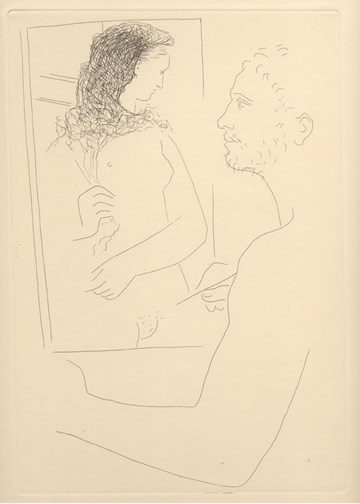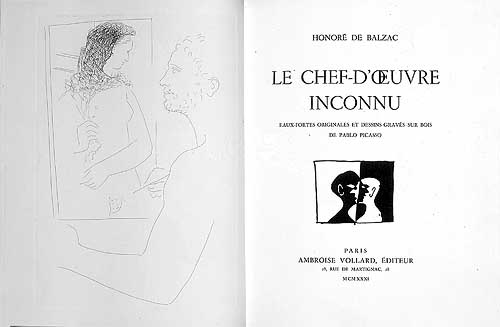 This
etching, Peintre
devant son Tableau (Painter in front of his easel) is from
1927 and one of Picasso's earliest etchings. He created only 18
prints of that medium in 1927 compared to later years when he would
create hundreds of etchings in a year.
This
etching, Peintre
devant son Tableau (Painter in front of his easel) is from
1927 and one of Picasso's earliest etchings. He created only 18
prints of that medium in 1927 compared to later years when he would
create hundreds of etchings in a year.
In early 1927 Picasso meets Marie-Thérèse
and has a secret relationship with her while being with Olga who he had
married in 1918. Could the young artist in this image be Picasso
painting a portrait of his new secret love? The first documented
painting of Marie-Thérèse
is not until 1932.
This etching is plate 11 of 13 used to illustrate the book "Le chef d'oeuvre
inconnu" by d'honore' de Balzac (1799-1799) as published
by Ambroise Vollard in 1931. The theme for all of the 13 etchings
was to be the artist and model. It is clear that this etching is
a precursor to the classical Vollard Suite which was created over the
next 10 years.

The etching is from the collection of Picasso's grand daughter, Marina
Picasso (born in 1951). It is one of the few and rare trial
proofs before the etching plate was steel faced and the full edition of
99 was then printed. There was also a smaller margin book edition
of 340 copies.
In November of 1948 Picasso was asked to create a lithograph of Balzac
by his lithographer, Fernand Mourlot. By the next day Picasso had
created not one, but rather eight lithographs and three larger
compositions in response to Mourlot's request.
Steel facing
is a modern technique whereby the soft copper plate into which the
image is
etched receives a thin coat of steel via electroplating in order to
harden its
surface.
In this way an edition can be printed from beginning to end
without
degradation of image quality, unlike Rembrandt etchings, for example,
whose
bare copper plates wore down from the pressure of the press over the
course of
printing an edition. This resulted in a visible softening of
lines, as
well as
a diminishing of subtle contrasts and tonal depth in examples from late
in a
print run.
Although steel facing allows for consistent quality
throughout an
edition and is thus an improvement over a bare copper plate, the
process
necessarily reduces textural delicacy and tonal depth to some degree.
Therefore, proofs before steel facing are the ultimate vehicles for
displaying
both the full expressive capacity of the etching process and in so
doing that
of the artist's hand.
 This
etching,
This
etching,  This
etching, Peintre
devant son Tableau (Painter in front of his easel) is from
1927 and one of Picasso's earliest etchings. He created only 18
prints of that medium in 1927 compared to later years when he would
create hundreds of etchings in a year.
This
etching, Peintre
devant son Tableau (Painter in front of his easel) is from
1927 and one of Picasso's earliest etchings. He created only 18
prints of that medium in 1927 compared to later years when he would
create hundreds of etchings in a year.